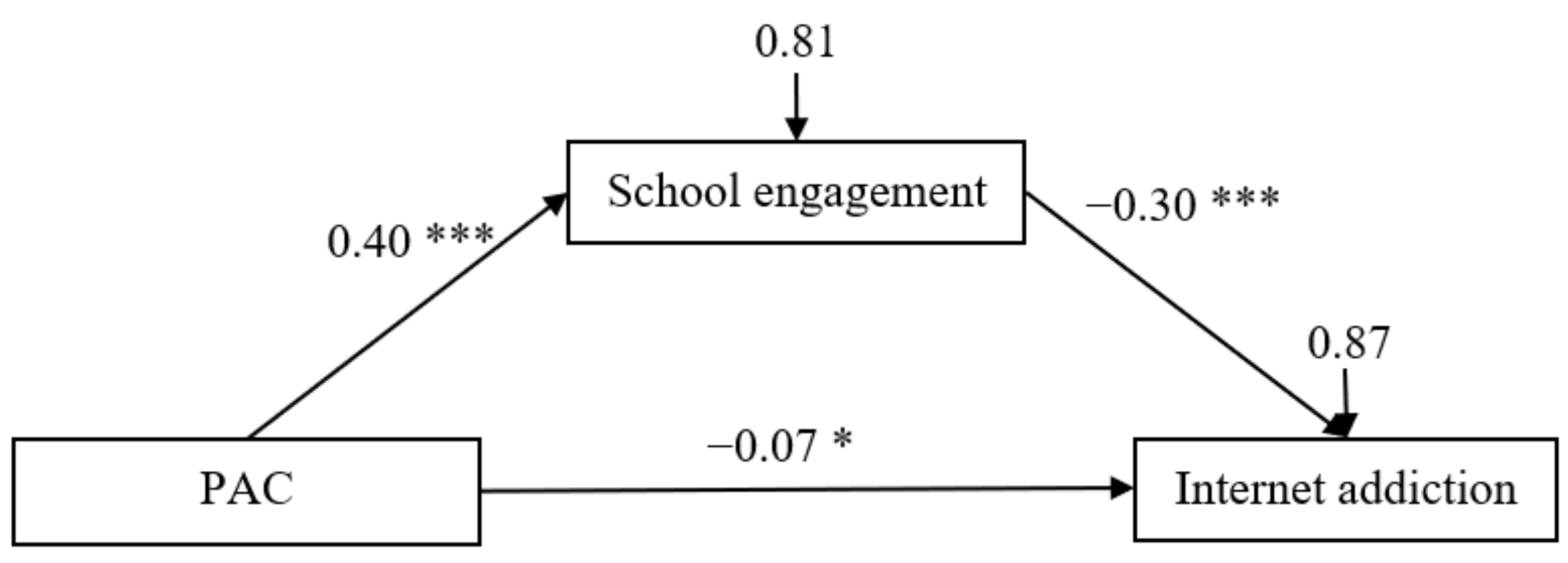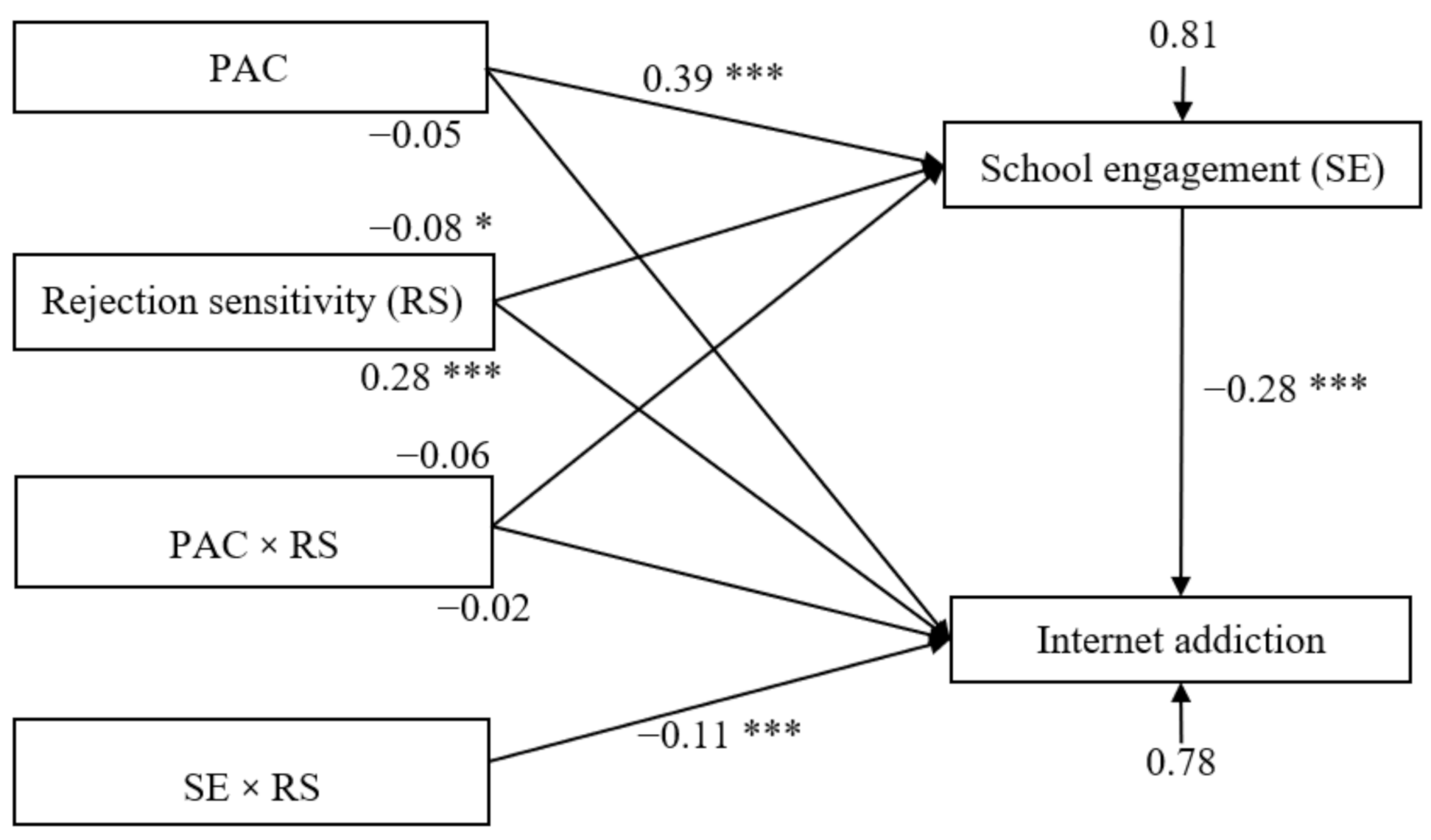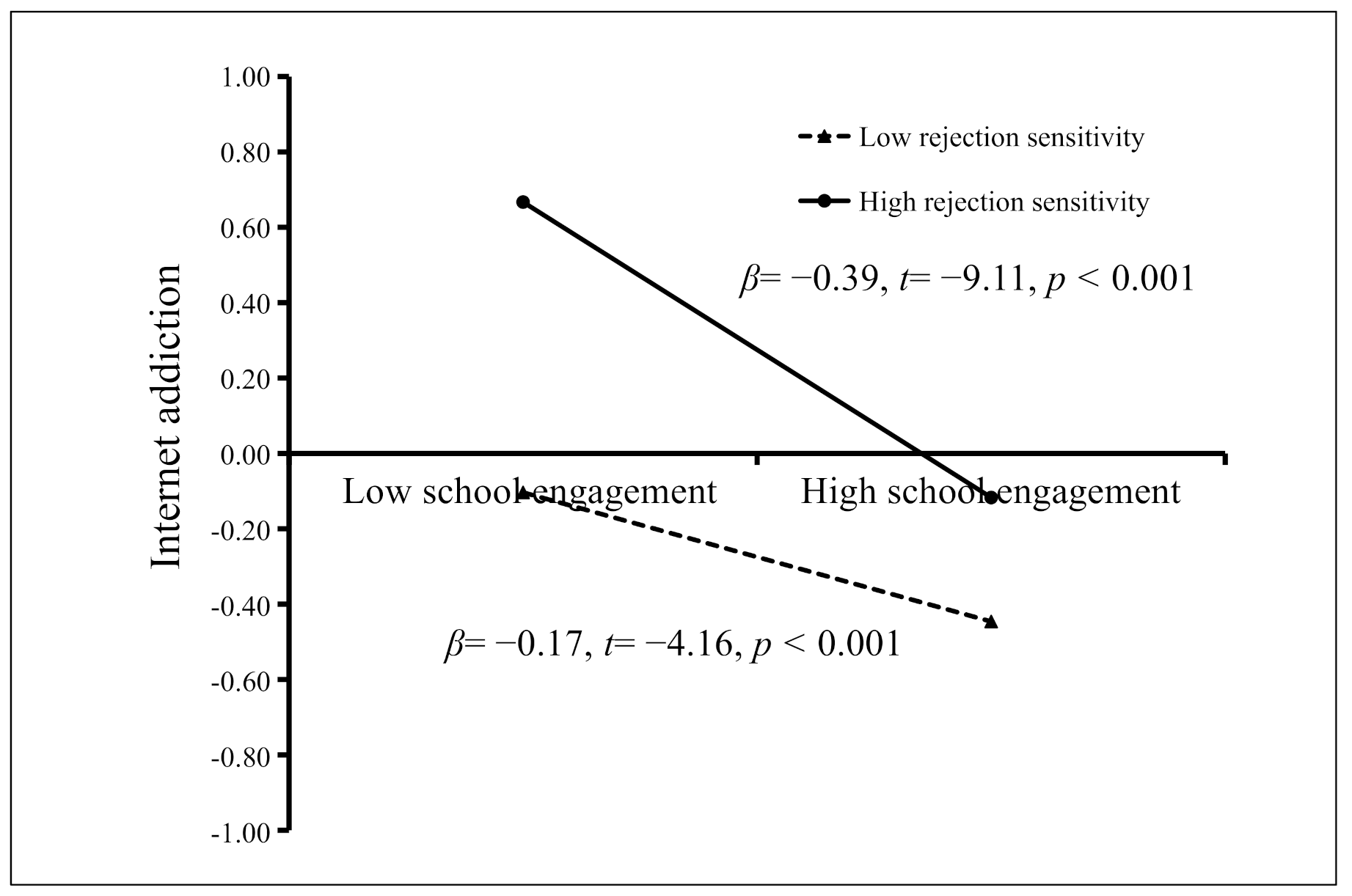Parent-Adolescent Communication, School Engagement, and Internet Addiction among Chinese Adolescents: The Moderating Effect of Rejection Sensitivity
Abstract
1. Introduction
1.1. Parent-Adolescent Communication and Adolescent Internet Addiction
1.2. School Engagement as a Potential Mediator
1.3. Rejection Sensitivity as a Moderator
2. Methods
2.1. Participants
2.2. Measures
2.2.1. Parent-Adolescent Communication
2.2.2. Internet Addiction
2.2.3. School Engagement
2.2.4. Rejection Sensitivity
2.2.5. Control Variables
2.3. Procedure and Statistical Analyses
3. Results
3.1. Preliminary Analyses
3.2. Testing for the Mediation Effect of School Engagement
3.3. Testing for the Moderated Mediation
4. Discussion
5. Conclusions
Author Contributions
Funding
Institutional Review Board Statement
Informed Consent Statement
Data Availability Statement
Conflicts of Interest
References
- Young, K.S. Internet addiction: The emergence of a new clinical disorder. Cyberpsychol. Behav. 1998, 1, 237–244. [Google Scholar] [CrossRef]
- Wang, Y.; Zhao, Y.; Liu, L.; Chen, Y.; Jin, Y. The current situation of internet addiction and its impact on sleep quality and self-injury behavior in Chinese medical students. Psychiatr. Investig. 2020, 17, 385. [Google Scholar] [CrossRef] [PubMed]
- Song, J.; Ma, C.; Gu, C.; Zuo, B. What Matters Most to the Left-Behind Children’s Life Satisfaction and School Engagement: Parent or Grandparent? J. Child Family Stud. 2018, 27, 2481–2490. [Google Scholar] [CrossRef]
- Spada, M.M. An overview of problematic internet use. Addic. Behav. 2014, 39, 3–6. [Google Scholar] [CrossRef]
- Park, S.; Kang, M.; Kim, E. Social relationship on problematic Internet use (PIU) among adolescents in South Korea: A moderated mediation model of self-esteem and self-control. Comput. Hum. Behav. 2014, 38, 349–357. [Google Scholar] [CrossRef]
- Peris, M.; Barrera, U.D.L.; Schoeps, K.; Montoya-Castilla, I. Psychological Risk Factors that Predict Social Networking and Internet Addiction in Adolescents. Int. J. Environ. Res. Public Health 2020, 17, 4598. [Google Scholar] [CrossRef] [PubMed]
- Weinstein, A.; Lejoyeux, M. Internet addiction or excessive internet use. Am. J. Drug. Alcohol. Abuse 2010, 36, 277–283. [Google Scholar] [CrossRef]
- Venkatesh, V.; Sykes, T.A.; Chan, F.K.Y.; Thong, J.Y.L.; Hu, J.H. Children’s internet addiction, family-to-work conflict, and job outcomes. Mis. Quart. 2019, 43, 903–927. [Google Scholar] [CrossRef]
- Xu, J.; Shen, L.X.; Yan, C.H.; Hu, H.; Yang, F.; Wang, L.; Liao, X.P. Parent-adolescent interaction and risk of adolescent internet addiction: A population-based study in Shanghai. BMC Psychiatry 2014, 14, 112. [Google Scholar] [CrossRef]
- Chou, H.L.; Chou, C. A quantitative analysis of factors related to Taiwan teenagers’ smartphone addiction tendency using a random sample of parent-child dyads. Comput. Hum. Behav. 2019, 99, 335–344. [Google Scholar] [CrossRef]
- Ding, Q.; Li, D.; Zhou, Y.; Dong, H.; Luo, J. Perceived parental monitoring and adolescent internet addiction: A moderated mediation model. Addic. Behav. 2017, 74, 48–54. [Google Scholar] [CrossRef] [PubMed]
- Barnes, H.L.; Olson, D.H. Parent-adolescent communication and the circumplex model. Child Dev. 1985, 56, 438–447. [Google Scholar] [CrossRef]
- Delgado, M.Y.; Nair, R.L.; Updegraff, K.A.; Umaña-Taylor, A.J. Discrimination, Parent–Adolescent Conflict, and Peer Intimacy: Examining Risk and Resilience in Mexican-Origin Youths’ Adjustment Trajectories. Child Dev. 2019, 90, 894–910. [Google Scholar] [CrossRef] [PubMed]
- Liu, Q.X.; Fang, X.Y.; Deng, L.Y.; Zhang, J.T. Parent–adolescent communication, parental Internet use and Internet-specific norms and pathological Internet use among Chinese adolescents. Comput. Hum. Behav. 2012, 28, 1269–1275. [Google Scholar] [CrossRef]
- Wang, W.; Li, D.; Li, X.; Wang, Y.; Sun, W.; Zhao, L.; Qiu, L. Parent-adolescent relationship and adolescent internet addiction: A moderated mediation model. Addic. Behav. 2018, 84, 171–177. [Google Scholar] [CrossRef]
- Lam, L.T. The Roles of Parent-and-Child Mental Health and Parental Internet Addiction in Adolescent Internet Addiction: Does a Parent-and-Child Gender Match Matter? Front. Public Health 2020, 8, 142. [Google Scholar] [CrossRef] [PubMed]
- Park, S.K.; Kim, J.Y.; Cho, C.B. Prevalence of Internet addiction and correlations with family factors among South Korean adolescents. Adolescence 2008, 43, 895–909. [Google Scholar]
- Yang, X.; Zhu, L.; Chen, Q.; Song, P.; Wang, Z. Parent marital conflict and Internet addiction among Chinese college students: The mediating role of father-child, mother-child, and peer attachment. Comput. Hum. Behav. 2016, 59, 221–229. [Google Scholar] [CrossRef]
- Bowen, M. The use of family theory in clinical practice. Compr. Psychiatry 1966, 7, 345–374. [Google Scholar] [CrossRef]
- Bowen, M. Alcoholism as viewed through family systems theory and family psychotherapy. Ann. N. Y. Acad. Sci. 2010, 233, 115–122. [Google Scholar] [CrossRef]
- Kang, J.; Park, H.; Park, T.; Park, J. Path Analysis for Attachment, Internet Addiction, and Interpersonal Competence of College Students. Com. Comput. Info. Sci. 2012, 342, 217–224. [Google Scholar]
- Soh, P.C.H.; Chew, K.W.; Koay, K.Y.; Ang, P.H. Parents vs peers’ influence on teenagers’ Internet addiction and risky online activities. Telemat. Inform. 2018, 35, 225–236. [Google Scholar] [CrossRef]
- Wang, M.T.; Fredricks, J.A. The Reciprocal Links Between School Engagement, Youth Problem Behaviors, and School Dropout during Adolescence. Child Dev. 2014, 85, 722–737. [Google Scholar] [CrossRef] [PubMed]
- Hirschi, T. Causes of Delinquency; University of California Press: Berkeley, CA, USA, 1969. [Google Scholar]
- Fachmi, T.; Latifa, R.; Syahid, A.H.; Kheryadi; Rachmadtullah, R. School Engagement Predictors for Indonesian Islamic Student. Edu. Res. 2019, 7, 2217–2226. [Google Scholar] [CrossRef]
- Tian, Y.; Yu, C.; Lin, S.; Lu, J.; Liu, Y.; Zhang, W. Sensation Seeking, Deviant Peer Affiliation, and Internet Gaming Addiction among Chinese Adolescents: The Moderating Effect of Parental Knowledge. Front. Psychol 2019, 9, 2727. [Google Scholar] [CrossRef]
- Fredricks, J.A.; Blumenfeld, P.C.; Paris, A.H. School Engagement: Potential of the Concept, State of the Evidence. Rev. Edu. Res. 2004, 74, 59–109. [Google Scholar] [CrossRef]
- Li, W.; Gao, W.; Sha, J. Perceived Teacher Autonomy Support and School Engagement of Tibetan Students in Elementary and Middle Schools: Mediating Effect of Self-Efficacy and Academic Emotions. Front. Psychol. 2020, 11, 50. [Google Scholar] [CrossRef]
- Li, Y.; Lerner, R.M. Trajectories of school engagement during adolescence: Implications for grades, depression, delinquency, and substance use. Dev. Psychol. 2011, 47, 233–247. [Google Scholar] [CrossRef] [PubMed]
- Ta, B. Relationship between internet addiction, gaming addiction and school engagement among adolescents. Univers. J. Educ. Res. 2017, 5, 2304–2311. [Google Scholar]
- Salmela-Aro, K.; Upadyaya, K. School engagement and school burnout profiles during high school: The role of socio-emotional skills. Eur. J. Dev. Psychol. 2020, 2, 1–22. [Google Scholar]
- Skinner, E.A.; Pitzer, J.R. Developmental Dynamics of Student Engagement, Coping, and Everyday Resilience. In Handbook of Research on Student Engagement; Springer: Boston, MA, USA, 2012; pp. 21–44. [Google Scholar]
- Skinner, E.A.; Kindermann, T.A.; Connell, J.P.; Wellborn, J.G. Engagement and disaffection as organizational constructs in the dynamics of motivational development. In Handbook of Motivation at School; Educational Psychology Handbook Series; Routledge/Taylor & Francis Group: New York, NY, USA, 2009; pp. 223–245. [Google Scholar]
- Furrer, C.; Skinner, E. Sense of Relatedness as a Factor in Children’s Academic Engagement and Performance. J. Edu. Psychol. 2003, 95, 148–162. [Google Scholar] [CrossRef]
- Ryan, R.M.; Stiller, J.D.; Lynch, J.H. Representations of relationships to teachers, parents, and friends as predictors of academic motivation and self-Esteem. J. Early. Adolesc. 1994, 14, 226–249. [Google Scholar] [CrossRef]
- Schaub; Maryellen. Is there a home advantage in school readiness for young children? Trends in parent engagement in cognitive activities with young children, 1991–2001. J. Early Child Res. 2015, 13, 47–63. [Google Scholar] [CrossRef]
- Bowlby, J. Attachment. In Attachment and Loss, 2nd ed.; Basic Books: New York, NY, USA, 1982; Volume 1. [Google Scholar]
- Daniel, G.R.; Cen, W.; Berthelsen, D. Early school-based parent involvement, children’s self-regulated learning and academic achievement: An Australian longitudinal study. Early Childhood Res. Q. 2016, 36, 168–177. [Google Scholar] [CrossRef]
- Amani, M.; Nazifi, M.; Sorkhabi, N. Parenting styles and academic achievement of early adolescent girls in Iran: Mediating roles of parent involvement and self-regulated learning. Eur. J. Psychol. Edu. 2019, 35, 49–72. [Google Scholar] [CrossRef]
- Cummings, E.M.; Davies, P.T.; Campbell, S.B. Developmental Psychopathology and Family Process: Theory, Research, and Clinical Implications; The Guilford Press: New York, NY, USA, 2002. [Google Scholar]
- Downey, G.; Feldman, S.I. Implications of rejection sensitivity for intimate relationships. J. Pers. Soc. Psychol. 1996, 70, 1327–1343. [Google Scholar] [CrossRef]
- Downey, G.; Feldman, S.; Ayduk, O. Rejection sensitivity and male violence in romantic relationships. Pers. Relatsh. 2010, 7, 45–61. [Google Scholar] [CrossRef]
- Fontana, A.; Callea, A.; Casini, E.; Curti, V. Rejection Sensitivity and internet addiction in adolescence: Exploring the mediating role of emerging personality disorders. Clin. Neuropsychiatry 2018, 15, 206–214. [Google Scholar]
- Hawes, T.; Zimmer-Gembeck, M.J.; Campbell, S.M. Unique associations of social media use and online appearance preoccupation with depression, anxiety, and appearance rejection sensitivity. Body Image 2020, 33, 66–76. [Google Scholar] [CrossRef]
- Wang, Y.; Tian, L.; Scott Huebner, E. Basic psychological needs satisfaction at school, behavioral school engagement, and academic achievement: Longitudinal reciprocal relations among elementary school students. Contemp. Educ. Psychol. 2019, 56, 130–139. [Google Scholar] [CrossRef]
- Passiatore, Y.; Grimaldi Capitello, T.; De Stasio, S.; Millioni, M.; Gentile, S.; Fiorilli, C. Children’s Mathematics and Verbal Self-concepts and Externalizing Behaviors: The Moderating Role of Peer Rejection at School. Front. Psychol. 2017, 8, 1912. [Google Scholar] [CrossRef] [PubMed]
- Rioux, C.; Castellanos-Ryan, N.; Parent, S.; Vitaro, F.; Séguin, J.R. The Interactive Effects of Parental Knowledge with Impulsivity and Sensation Seeking in Adolescent Substance Use. Child Psychiatry Hum. Dev. 2019, 50, 95–107. [Google Scholar] [CrossRef] [PubMed]
- Li, D.; Zhang, W.; Li, X.; Zhen, S.; Wang, Y. Stressful life events and problematic Internet use by adolescent females and males: A mediated moderation model. Comput. Hum. Behav. 2010, 26, 1199–1207. [Google Scholar] [CrossRef]
- Mak, K.K.; Young, K.S. Development and Differential Item Functioning of the Internet Addiction Test-Revised (IAT-R): An Item Response Theory Approach. Cyberpsychol. Behav. 2020, 23, 312–328. [Google Scholar] [CrossRef]
- Takayoshi; DOI. Liquefaction of social relationships, solidification of fellowship groups. J. Inform. Edu. 2018, 1, 15–22. [Google Scholar]
- Taylor, C. The relationship between social and self-control: Tracing Hirschi’s criminological career. Theor. Criminol. 2001, 5, 369–388. [Google Scholar] [CrossRef]
- Downey, G.; Lebolt, A.; Rincón, C.; Freitas, A.L. Rejection sensitivity and children’s interpersonal difficulties. Child. Dev. 2010, 69, 1074–1091. [Google Scholar] [CrossRef]
- Grazia, V.; Molinari, L. Rejection sensitivity and relational wellbeing in adolescence. Psicologia Clinica Dello. Sviluppo 2018, 22, 399–410. [Google Scholar]
- Kraines, M.A.; Kelberer, L.J.A.; Wells, T.T. Rejection sensitivity, interpersonal rejection, and attention for emotional facial expressions. J. Behav. Ther. Exp. Psychiatry 2018, 59, 31–39. [Google Scholar] [CrossRef]
- London, B.; Downey, G.; Bonica, C.; Paltin, I. Social Causes and Consequences of Rejection Sensitivity. J. Res. Adolesc. 2007, 17, 481–506. [Google Scholar] [CrossRef]
- Morrow, M.T.; Hubbard, J.A.; Barhight, L.J.; Thomson, A.K. Fifth-Grade Children’s Daily Experiences of Peer Victimization and Negative Emotions: Moderating Effects of Sex and Peer Rejection. J. Abnorm. Child Psychol. 2014, 42, 1089–1102. [Google Scholar] [CrossRef]
- Su, S.; Li, X.; Lin, D.; Xu, X.; Zhu, M. Psychological adjustment among left-behind children in rural China: The role of parental migration and parent-child communication. Child Care Health Dev. 2013, 39, 162–170. [Google Scholar] [CrossRef]
- Pontes, H.M.; Griffiths, M.D. Measuring DSM-5 internet gaming disorder: Development and validation of a short psychometric scale. Comput. Hum. Behav. 2015, 45, 137–143. [Google Scholar] [CrossRef]
- Cyders, M.A.; Littlefield, A.K.; Coffey, S.; Karyadi, K.A. Examination of a short English version of the UPPS-P Impulsive Behavior Scale. Addict. Behav. 2014, 39, 1372–1376. [Google Scholar] [CrossRef] [PubMed]
- Muthén, L.K.; Muthén, B.O. Mplus User’s Guide, 1998–2012, 7th ed.; Muthén & Muthén: Los Angeles, CA, USA, 1998. [Google Scholar]
- Hoyle, R.H. Handbook of Structural Equation Modeling; Guilford Press: New York, NY, USA, 2012. [Google Scholar]
- Forrest-Bank, S.S.; Jenson, J.M. The relationship among childhood risk and protective factors, racial microaggression and ethnic identity, and academic self-efficacy and antisocial behavior in young adulthood. Children Youth Serv. Rev. 2015, 50, 64–74. [Google Scholar] [CrossRef]
- Voisin, D.R.; Elsaesser, C.M. Pathways from Polyvictimization to Youth Problem Behaviors: The Critical Role of School Engagement. Int. J. Higher Educ. 2013, 2, 15–30. [Google Scholar] [CrossRef]
- Waters, E.; Stewart-Brown, S.; Fitzpatrick, R. Agreement between adolescent self-report and parent reports of health and well-being: Results of an epidemiological study. Child Care Health Dev. 2003, 29, 501–509. [Google Scholar] [CrossRef]
- Lopez, F.G.; Gover, M.R. Self-report measures of parent-adolescent attachment and separation-individuation: A selective review. J. Counsel. Dev. 1993, 71, 560–569. [Google Scholar] [CrossRef]




| Variables | 1 | 2 | 3 | 4 |
|---|---|---|---|---|
| 1. PAC | 1.00 | |||
| 2. Rejection sensitivity | −0.13 *** | 1.00 | ||
| 3. School engagement | 0.41 *** | −0.14 *** | 1.00 | |
| 4. Internet addiction | −0.20 *** | 0.29 *** | −0.34 *** | 1.00 |
| Mean | 2.26 | 3.04 | 3.91 | 1.26 |
| SD | 0.53 | 0.43 | 0.49 | 0.28 |
Publisher’s Note: MDPI stays neutral with regard to jurisdictional claims in published maps and institutional affiliations. |
© 2021 by the authors. Licensee MDPI, Basel, Switzerland. This article is an open access article distributed under the terms and conditions of the Creative Commons Attribution (CC BY) license (http://creativecommons.org/licenses/by/4.0/).
Share and Cite
Li, J.; Yu, C.; Zhen, S.; Zhang, W. Parent-Adolescent Communication, School Engagement, and Internet Addiction among Chinese Adolescents: The Moderating Effect of Rejection Sensitivity. Int. J. Environ. Res. Public Health 2021, 18, 3542. https://doi.org/10.3390/ijerph18073542
Li J, Yu C, Zhen S, Zhang W. Parent-Adolescent Communication, School Engagement, and Internet Addiction among Chinese Adolescents: The Moderating Effect of Rejection Sensitivity. International Journal of Environmental Research and Public Health. 2021; 18(7):3542. https://doi.org/10.3390/ijerph18073542
Chicago/Turabian StyleLi, Jingjing, Chengfu Yu, Shuangju Zhen, and Wei Zhang. 2021. "Parent-Adolescent Communication, School Engagement, and Internet Addiction among Chinese Adolescents: The Moderating Effect of Rejection Sensitivity" International Journal of Environmental Research and Public Health 18, no. 7: 3542. https://doi.org/10.3390/ijerph18073542
APA StyleLi, J., Yu, C., Zhen, S., & Zhang, W. (2021). Parent-Adolescent Communication, School Engagement, and Internet Addiction among Chinese Adolescents: The Moderating Effect of Rejection Sensitivity. International Journal of Environmental Research and Public Health, 18(7), 3542. https://doi.org/10.3390/ijerph18073542





